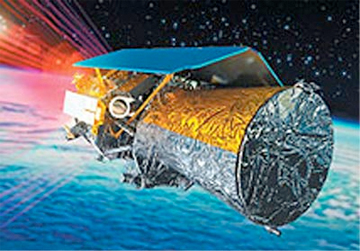[Satnews] Orbital ATK, Inc. (NYSE: OA) announces their conclusion of eight years of mission support for the Near Field Infrared Experiment (NFIRE) satellite with the decommissioning of the spacecraft on August 5, 2015.

Sponsored by the U.S. Missile Defense Agency (MDA), and built at Orbital ATK’s satellite manufacturing facility in Gilbert, Arizona, NFIRE was originally designed as a one-year mission to collect data from exhaust “plume” observations of boosting rockets with the intent to advance launch detection and tracking systems. The addition of the Laser Communications Terminal (LCT) expanded NFIRE’s mission to assess viability of satellite-to-satellite high speed communication links. During its eight years on orbit, NFIRE helped advance the state-of-the-art ballistic missile detection system, accomplished bi-directional satellite laser communications at will and boosted international collaboration with Germany.
NFIRE launched in April 2007 aboard an Orbital ATK Minotaur I from Wallops Island, Virginia. Orbital ATK was the system integrator for the NFIRE mission, with responsibility for the design and manufacture of the defense satellite, based on the company’s flight-proven LEOStar™ spacecraft architecture. Other contributions included payload integration, full satellite system testing, configuration of two ground mission operation centers and on-orbit operations support. Orbital ATK also led the mission assurance and systems engineering integrated product teams. After in-orbit testing was completed, the company turned the satellite over to the MDA for primary management.
NFIRE’s primary instrument has been the Track Sensor Payload, which has been able to collect data on targets of opportunity through precision detection and tracking despite environmental background clutter (i.e., atmospheric variables, clouds, land-sea visibility and more).
The secondary payload, the Laser Communications Terminal (LCT), supported successful laser communications demonstrations as part of a cooperative agreement between the U.S. and Germany. The German government provided the LCT for NFIRE and flew a sister spacecraft, the TerraSAR-X (TSX-1), with an identical LCT on board to conduct space-to-space links and space-to-ground experiments. Together, NFIRE and TSX-1 accomplished the first data transfer between two spacecraft at a rate of 5.6 gigabits per second.
The NFIRE decommissioning process encompassed three burns that progressively lowered the satellite’s orbit, dumped its fuel and left the spacecraft in a low-altitude orbit that will lead to atmospheric re-entry. Currently, the MDA is not planning a successor to NFIRE, but the mission’s legacy will continue within next-generation missile detection systems.
Executive Comment
“NFIRE is an example of a defense satellite that far exceeded its original intent and became a ‘shining star’ program of the Missile Defense Agency,” said Rick Kettner, Gilbert Site Manager for Orbital ATK. “The value of the NFIRE team’s hard work and data not only resulted in annual mission extensions from one year to eight, but also served as a pathfinder for sustaining systems like the Space Tracking and Surveillance System (STSS) and Germany’s ongoing Laser Communications Terminal applications.”
“From November 2008 to April 2015, NFIRE successfully executed more than 950 inter-satellite and satellite-to-ground laser communications links with its Laser Communications Terminal,” said Tawnie Harrison, Orbital ATK’s NFIRE Program Manager. “I’m proud of the team and the many technical accomplishments we achieved for our customer and partners over the mission lifetime.”


